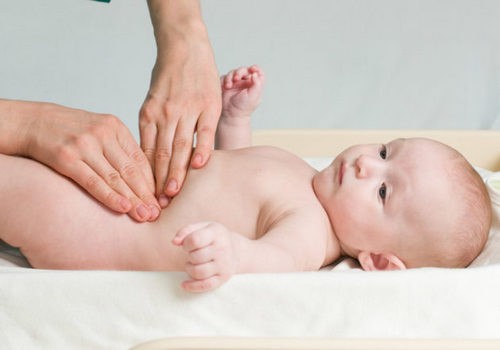Very often, parents are faced with a problem such as colic in a small child. Piercing crying, restless behavior caused by pain and bloating, bring a lot of feelings and problems to a young family. Colic is a spasm of the musculature of the intestinal wall caused by increased gas formation.
They are completely harmless, but very painful for the child. Massage for colic in newborns will help to cope with them.
The child’s body in the first weeks only learns to work in new conditions, different from intrauterine life. With intestinal colic, all babies face without exception. As a rule, at 4 months of life, the problem of intestinal colic goes away on its own. And up to this point, the parents have a task – to help their baby get rid of discomfort.
Why do babies get a massage?
Pain caused by spasm of the walls of the colon due to stretching of its gases does not occur from scratch. In newborns, the enzymatic system is poorly developed, the normal intestinal microflora is not formed, there are problems with motility of the digestive tract, especially if the baby is not applied to the breast correctly and it sucks in too much air during feeding.
Also, colic does not bypass babies, who mainly receive high-carbohydrate mother milk as a feed. This problem can be complicated by lactase deficiency, as a result of which gas production and food fermentation are intensified in the intestine.
The muscles of the abdominal cavity in the newborn are not yet developed, therefore, it cannot fully retain and carry out physiological massage of internal organs. If the child suffers from an umbilical hernia or diastasis of the abdominal muscles, then the likelihood of colic increases.
Massage for colic in a newborn helps relieve spasms, improves the movement of gases through the intestines and facilitates their exit. It should be carried out only for preventive purposes, and not during attacks of intestinal colic. Massage for colic in infants improves the absorption of food by the gastrointestinal tract, prevents the excessive formation of gases, and establishes bowel movements.
For the purpose of prevention, massage of the tummy in newborns is carried out daily, up to 6 times a day, 30 minutes after feeding. The movements during the procedure should be soft and soothing. The main emphasis is on the process of facilitating the discharge of gases.

Massage preparation
In the room where the massage will be carried out for the newborn from colic, the air temperature should be comfortable, since during the procedure the baby is completely undressed. The tummy before massage needs to be warmed up in advance. This can be done with an ironed diaper. Mom’s hands should also be warm. Touching cold fingers can be unpleasant for a child.
Massage the tummy of the newborn does not require any special conditions – it can be performed on a regular changing table, in a crib, and even on the lap of loving parents. It is not necessary to use various oils, as with conventional massage. On the contrary, experts insist that the parents’ hands remain dry or lightly treated with talcum powder, since there is no need for excessive slipping during massage of the abdomen in newborns.
Before starting the massage, the baby needs to be held upright for several minutes, because the air that has accumulated after feeding in the stomach can cause him a lot of discomfort during the procedure. Helping to get rid of it, you can prevent not only discomfort and pain, but also regurgitation during massage.
Contraindications
It is forbidden to massage children who have the following signs of trouble:
- the tummy is asymmetrically enlarged, one side is noticeably larger than the other;
- hands feel the wave-like contractile activity of the muscles of the digestive tract;
- gases in the child do not pass more than 24 hours;
- defecation did not occur during the day;
- the child looks lethargic, indifferent, cries, his skin is too pale;
- body temperature is elevated;
- drops of blood are visible in the anus;
- a round formation is palpated near the navel.
Any of these symptoms is an urgent reason to call an ambulance.
The right massage technique
Tummy massage in infants can be performed not only with colic. Let us consider below in what other cases and how this procedure should be performed.

Massage technique for colic:
- Bike. The child is laid on the back, taken by the knees and gently alternately press the legs to the tummy. No need to make efforts, massage should be accompanied by positive emotions and communication with the baby.
- On the ball. The child is laid on his belly on an inflatable ball and carefully rolls on the surface of the ball with adequate support. This massage is especially effective for constipation.
- Using your fingers. Connect the middle and forefinger and gently press on the left in the lower abdomen, then, rising up and to the right, describing the semicircle. After 3 times, the procedure ends in the lower abdomen.
- Foot massage. The child lies on his back, his legs are pressed to the tummy and the mother begins to perform circular movements from the central part of the abdomen to the sides and vice versa.
Massage technique for umbilical hernia
A specialist should tell the young mother how to massage the abdomen for a newborn with an umbilical hernia. The procedure begins with laying on the tummy. Then, light strokes are applied to the oblique muscles of the abdomen. The middle and index fingers are connected, placed on the navel, and a navel massage is performed clockwise for 2 minutes.
Then, performing a massage of the umbilical hernia in newborns, you need to put the back of your hand on the navel and make several screwing movements stroking the tummy. After that, using the thumb, you need to press on the navel itself, and with the middle and forefinger – on the area around it up to 4 times.
Swelling Massage Technique
Massage with bloating is performed as well as with intestinal colic. In addition, it is recommended to spread the child more often on the stomach, as well as warm his skin before performing the massage.
You can advise the massage technique “frog”. The child is laid on the tummy, the legs are bent at the knees and carefully spread apart. Mom’s palms support the feet in the form of a support. At the same time, active kids can push off, as if they want to jump forward. This technique helps free the intestines from excess gas and develop the muscles in the baby’s legs.
Massage technique for constipation
If a child has constipation, you first need to pay attention to his nutrition. Massage for constipation should not be done if the baby is crying and worried, and his tummy is very hard or painfully reacts to any touch. In this case, it is better to consult a doctor.
When the baby is calm, with constipation, it is necessary to stroke his stomach for at least 3 minutes clockwise, alternating stroking with pressing the legs to the tummy. This will help relax the muscles of the digestive tract, normalize motility and rid the baby of stool problems.
There is also a stomach-to-stomach method. In this case, the mother puts the baby on her belly, heat stimulates the activity of the intestines, and constipation disappears.

After massage
After a massage of the abdomen in newborns, defecation usually occurs with the simultaneous release of accumulated gases. Therefore, it is worthwhile to put a diaper under the baby’s ass before the procedure. To facilitate the passage of gases, immediately after the massage, it is recommended to press the baby’s legs to the tummy and hold them in this position for 30 seconds.
You can also perform a simple exercise “bicycle”, usually during its implementation the child begins to push better. Massage must be completed with soothing strokes.
Knowing how to massage the tummy of the newborn, and understanding why it should be done, young parents will be able to help their baby cope with the unpleasant symptoms of intestinal colic.



